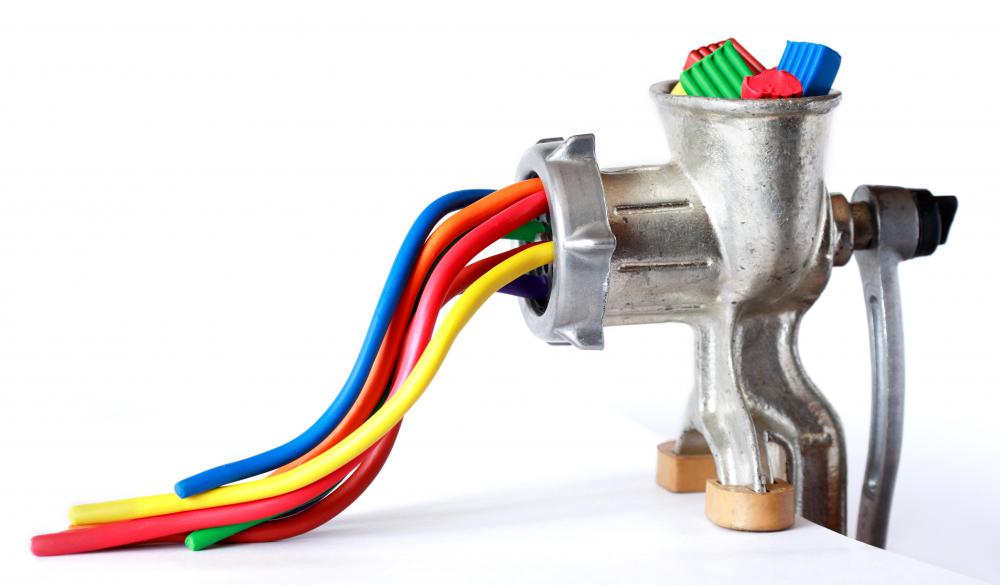At HomeQuestionsAnswered, we're committed to delivering accurate, trustworthy information. Our expert-authored content is rigorously fact-checked and sourced from credible authorities. Discover how we uphold the highest standards in providing you with reliable knowledge.
What is Plasticine?
Plasticine® is a trademark name for an oil-based modeling material that was developed by an art teacher in England in 1897. The non-drying clay that William Harbutt formulated is still available, as is plastilin, a similar modeling clay developed by Franz Kolb in the 1880s, but the terms plasticine and plastilina are now used by many people as generic terms for modeling clay.
This material has distinct properties that make it useful. Unlike clay and wax, it stays soft and workable: it neither hardens nor dries. It also comes in a wide array of colors, unlike pottery clay, that can be used as purchased or blended. Also, unlike clay, plasticine doesn’t stick to the hands.

Plasticine can be shaped and worked with modeling tools for shaping, sculpting, blending, texturing, thinning, scraping, poking, and cutting. It can be worked on its own or built on a pre-formed armature. Users should note, however, that it cannot be fired.
Two important uses of this material were developed recently. Canadian illustrator Barbara Reid has developed a book illustration technique using it to create illustrations of scenes as relief sculptures, employing a variety of techniques to convey distance, size, texture, and lighting. Her illustrations for The New Baby Calf by Edith Newlin Chase, copyright 1984, are the first published example of this technique. The Party, from 1997, for which Reid won the Governor General’s Literary Award, and The Subway Mouse, from 2003, are other works illustrated using this technique.

Probably the most famous new use of plasticine is in Claymation®, originally used solely as a servicemark for a type of stop-action movie animation process done with oil-based modeling clay that was invented by Wlll Vinton, the man responsible for animating the California raisins. The term claymation has come to be used generically to describe animation using modeling clay.
AS FEATURED ON:
AS FEATURED ON:














Discussion Comments
@ No 18: About 40 pounds.
@ No. 17: how much workable clay does this produce?
Found this recipe on another website, and thought it might be helpful for comment #5:
10 lbs Micro-crystalline Wax
1/2 gal Purified Mineral Oil
4 lbs Vaseline
25 lbs Clay Powder
Melt wax, oil and Vaseline together in an electric frying pan; stir clay powder in slowly once melted. Mix thoroughly and pour into shallow microwave-safe plastic containers. You can also use a portion of beeswax for part of the wax component for an even smoother clay. Don't use to much though, as it can become too sticky.
*or*
This is one that does not use clay, it works well.
480 g bee wax or Micro-crystalline Wax is less sticky
200 ml purified mineral oil
192 g vaseline
1200 g talc (white)
In an electric fry pan ( 60 C don't get it too hot to let wax smoke) mix beeswax + mineral oil + vaseline. Before they become entirely liquid, mix in the talc) you can play around a little with the amounts, mix the types of wax.
Calcium carbonate is also called lime, which is used to make whiting, plaster and concrete. It's cheaply available at any hardware store eg Bunnings, Mitre 10. For plasticine do not used the quick setting lime.
Where do you get calcium carbonate from?
put it in the microwave to get it warmer.
I have some old plasticine and it is too hard to work with. I note that the original was made with vaseline. can I soften it by adding some vaseline and try to work it into the mass of plasticine?
to Mr number 5: have you thought of trying linseed oil?
can anyone tell me what type of clay or plasticine to use for making fishing weights: i.e. reusable molds?
Can any one tell me how to make Plasticine at home?
I have 8 vintage packages of Harbutt's Plasticine from the early half of the 20th century. They are still wrapped in their original package and believe it or not, they're still pliable! I'm not sure what I'll do with them, but the packaging alone is classic.
I am a sculptor and i make my own clay. i use diesel motor oil, calcium carbonate and wax. readily available materials - cheap and simple ... and TOXIC. Is there a substitute for motor oil?
Can I make plasticine clay at home? How?
Or where can I get it for a cheap price?
"What happens to the composition of Plasticine if it get cold?"
it gets hard. on a cold day you have to warm it up in your hands to model with it
"is it used for sticking pins to other materials?"
ummm no
is it used for sticking pins to other materials?
What happens to the composition of Plasticine if it get cold?
Post your comments